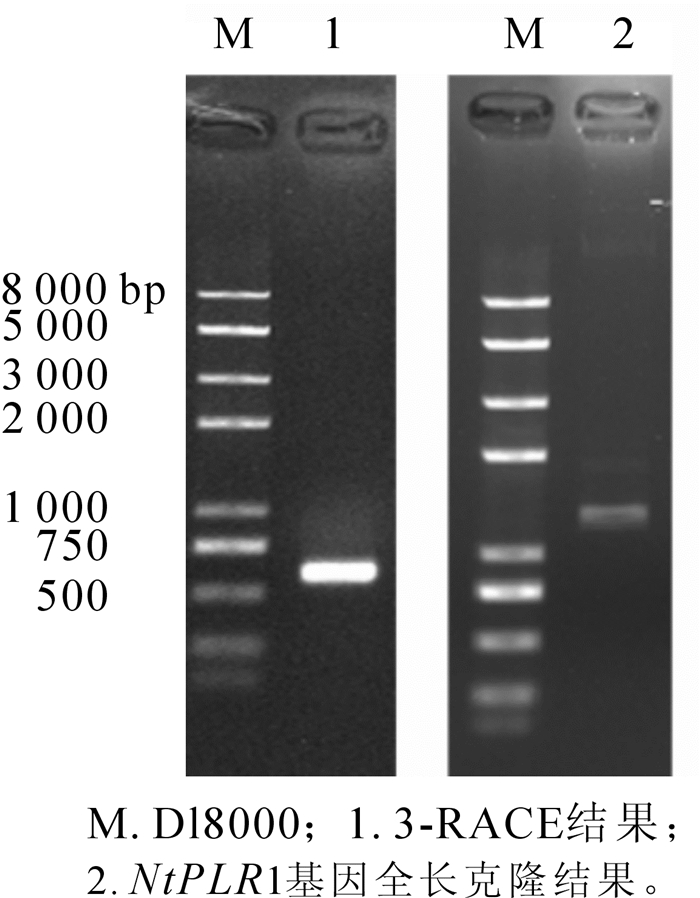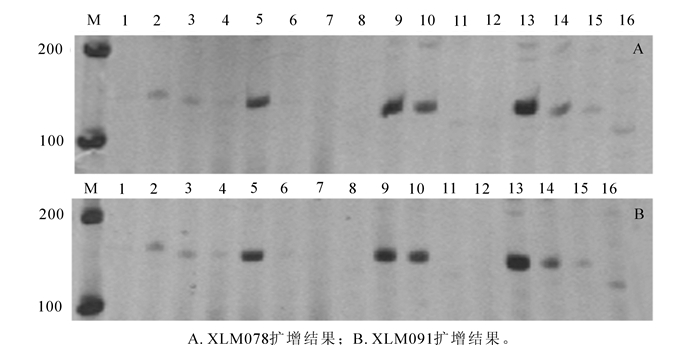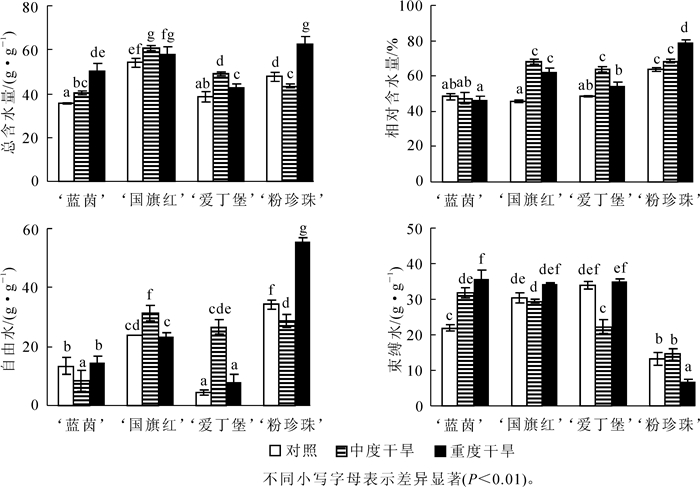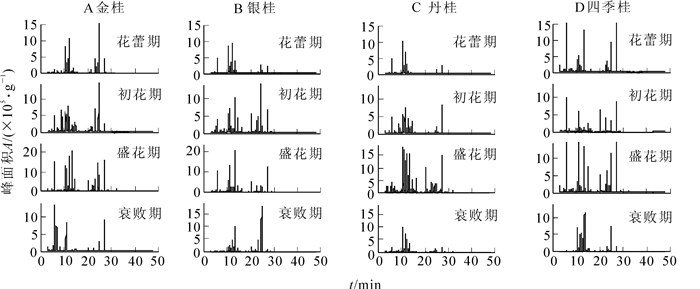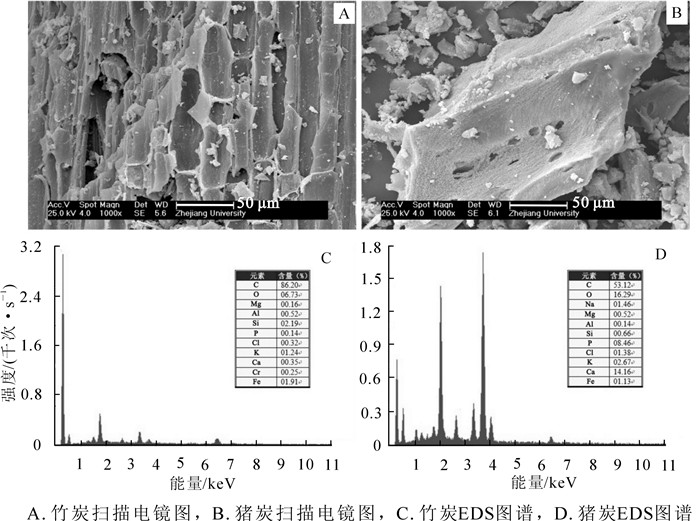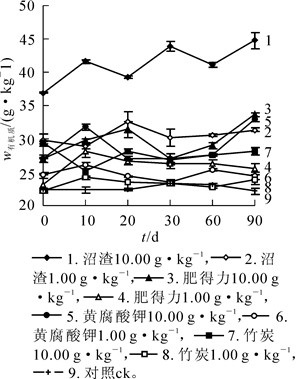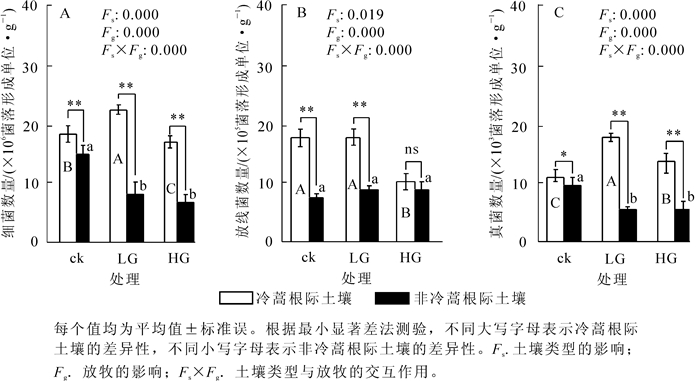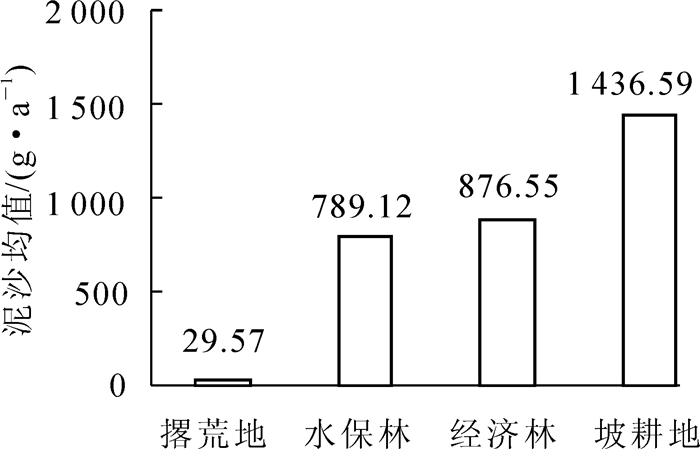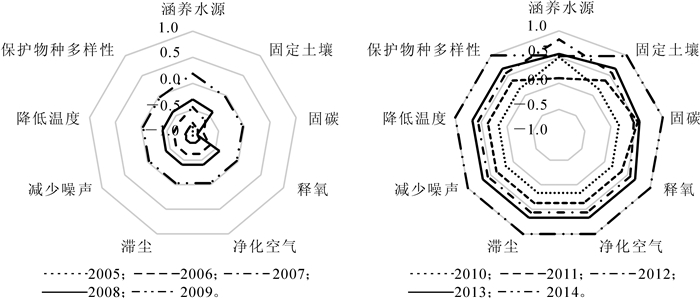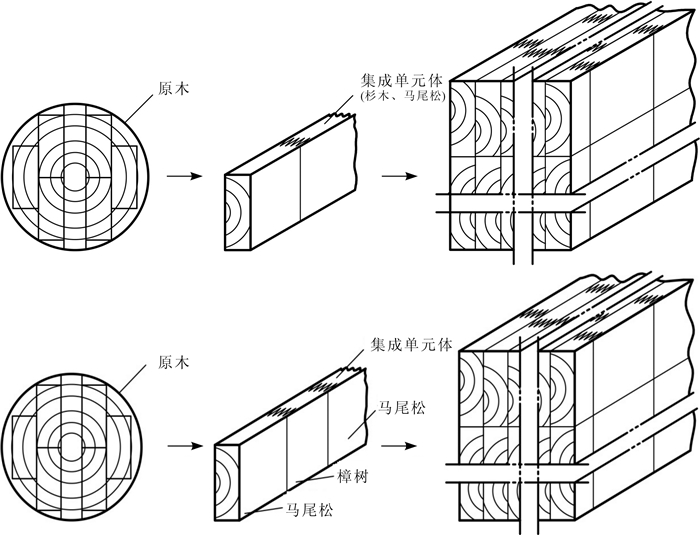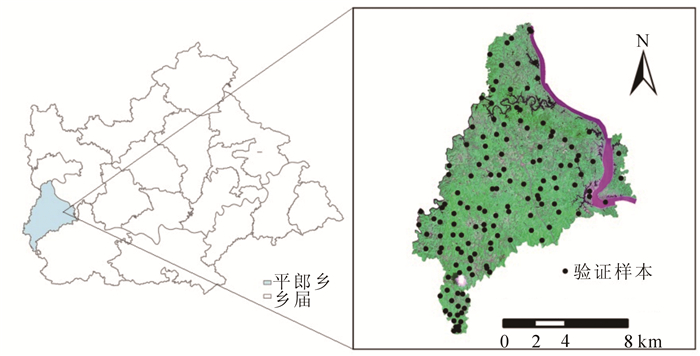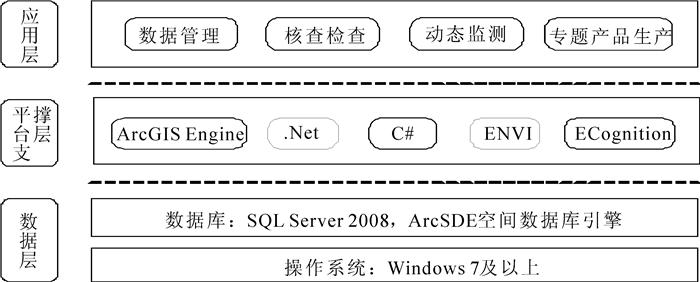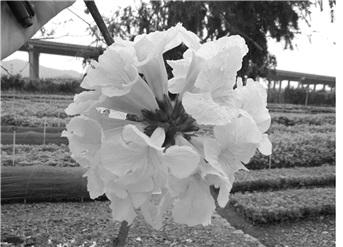2017 Vol. 34, No. 4
column
2017, 34(4): 565-573.
doi: 10.11833/j.issn.2095-0756.2017.04.001
Abstract:
Phyllostachys edulis, a major commercial bamboo species in China, utilizes cellulose synthesis, which mainly synthesizes cellulose deposited in the primary and secondary cell walls and is key in bamboo growth and development. This study was conducted to determine the structure and function of cellulose synthase as it promotes bamboo growth and development. Expression and function of cellulose synthase were researched with a bioinformatics analysis, transmission electron microscope (TEM), and quantitative real-time polymerase chain reaction (qRT-PCR). Results indicated that 16 members of the cellulose synthase family were predicted, and the proteins contained a cellulose-synt motif and a zinc finger motif on the N terminus using domain prediction. Cell phloem ultrastructures of Ph. edulis showed that the secondary cell wall was thicker with an increasing height of bamboo, and first appeared in the basal part (first 1.2 m). Eight cellulose synthase genes (PeCesA1, PeCesA2, PeCesA3, PeCesA4, PeCesA5, PeCesA6, PeCesA9, and PeCesA13) had a high expression on parts of the secondary cell wall; whereas, three cellulose synthase genes (PeCesA6, PeCesA9, and PeCesA13) had a high expression on parts of the primary cell wall. Based on previous studies of bamboo cellulose content for the same growth stages, for young bamboo, PeCesA1, PeCesA2, PeCesA3, PeCesA4, and PeCesA5 were the main genes responsible for the secondary cell wall; and PeCesA6, PeCesA9, and PeCesA13 were likely involved in building both primary and secondary cell walls.
Phyllostachys edulis, a major commercial bamboo species in China, utilizes cellulose synthesis, which mainly synthesizes cellulose deposited in the primary and secondary cell walls and is key in bamboo growth and development. This study was conducted to determine the structure and function of cellulose synthase as it promotes bamboo growth and development. Expression and function of cellulose synthase were researched with a bioinformatics analysis, transmission electron microscope (TEM), and quantitative real-time polymerase chain reaction (qRT-PCR). Results indicated that 16 members of the cellulose synthase family were predicted, and the proteins contained a cellulose-synt motif and a zinc finger motif on the N terminus using domain prediction. Cell phloem ultrastructures of Ph. edulis showed that the secondary cell wall was thicker with an increasing height of bamboo, and first appeared in the basal part (first 1.2 m). Eight cellulose synthase genes (PeCesA1, PeCesA2, PeCesA3, PeCesA4, PeCesA5, PeCesA6, PeCesA9, and PeCesA13) had a high expression on parts of the secondary cell wall; whereas, three cellulose synthase genes (PeCesA6, PeCesA9, and PeCesA13) had a high expression on parts of the primary cell wall. Based on previous studies of bamboo cellulose content for the same growth stages, for young bamboo, PeCesA1, PeCesA2, PeCesA3, PeCesA4, and PeCesA5 were the main genes responsible for the secondary cell wall; and PeCesA6, PeCesA9, and PeCesA13 were likely involved in building both primary and secondary cell walls.
2017, 34(4): 574-580.
doi: 10.11833/j.issn.2095-0756.2017.04.002
Abstract:
The auxin response factor (ARF) gene family plays a key role in plant growth and developmental processes, such as root and shoot development as well as flower and fruit development. To provide a theoretical basis for flower and seed development of Phyllostachys edulis, a genome-wide analysis of the previously undocumented ARF gene family for Ph. edulis was conducted. In this study a whole-genome survey of Ph. edulis was performed and a detailed analysis of the gene motif and phylogenetic classification was provided. Results showed 44 ARF genes which were classified into three groups. A comparative analysis of the ARF genes among Ph. edulis, rice, and Arabidopsis suggested a total of 11 sister pairs (OsARF-PheARF) providing insights into various orthologous relationships between OsARFs and PheARFs. For ARF expression patterns of diverse floral organs, PheARF13, PheARF14, and PheARF35 showed the highest expression in the flower bud, pistil, and young embryo; whereas, PheARF2, PheARF30, PheARF14, PheARF13, PheARF35, PheARF7, PheARF37, and PheARF38 were highly expressed in the pistil and the young embryo. This study suggested that ARF genes may play a very critical role during flower and fruit development of Ph. edulis.
The auxin response factor (ARF) gene family plays a key role in plant growth and developmental processes, such as root and shoot development as well as flower and fruit development. To provide a theoretical basis for flower and seed development of Phyllostachys edulis, a genome-wide analysis of the previously undocumented ARF gene family for Ph. edulis was conducted. In this study a whole-genome survey of Ph. edulis was performed and a detailed analysis of the gene motif and phylogenetic classification was provided. Results showed 44 ARF genes which were classified into three groups. A comparative analysis of the ARF genes among Ph. edulis, rice, and Arabidopsis suggested a total of 11 sister pairs (OsARF-PheARF) providing insights into various orthologous relationships between OsARFs and PheARFs. For ARF expression patterns of diverse floral organs, PheARF13, PheARF14, and PheARF35 showed the highest expression in the flower bud, pistil, and young embryo; whereas, PheARF2, PheARF30, PheARF14, PheARF13, PheARF35, PheARF7, PheARF37, and PheARF38 were highly expressed in the pistil and the young embryo. This study suggested that ARF genes may play a very critical role during flower and fruit development of Ph. edulis.
2017, 34(4): 581-588.
doi: 10.11833/j.issn.2095-0756.2017.04.003
Abstract:
Vitamin B6 (VB6), essential for plant growth and development and involved in more than 100 biological processes, utilizes pyridoxal reductase (PLR) as the key enzyme in the VB6 salvage pathway, thereby catalyzing pyridoxal (PL) to generate pyridoxine (PN). Since studies on PLR of plant VB6 are quite limited, PLR genes were cloned and characterized to improve understanding of VB6 biosynthesis in plants. Several NtPLR1 gene fragments were found in Nicotiana tabacum through a homologous blast with Arabidopsis AtPLR1. Full length was obtained using rapid amplification of cDNA ends (RACE). Real-time quantitative polymerase chain reaction (PCR) and high performance liquid chromatography (HPLC) analysis were conducted; NtPLR1 expression by ultraviolet, oxidation, exogenous PL, and NaCl treatments were compared to a control; and prokaryotic expression of NtPLR1 was accomplished. Results of RACE showed that full length cDNA of NtPLR1 was 1 370 bp, which encoded 369 amino acid residues with a protein molecular weight of about 41 kDa and a theoretical isoelectric point of 9.42. Real-time quantitative PCR analysis revealed that an exogenous PL treatment induced NtPLR1 expression with highest expression at 4 d. The HPLC analysis showed that PL content significantly decreased (P < 0.05); whereas, PN content significantly increased (P < 0.05) during an exogenous PL treatment. NtPLR1 was expressed in roots, stems, and leaves with leaves having the highest (P < 0.05) expression level. Also, ultraviolet, oxidation, and NaCl treatments, compared to a control, significantly induced (P < 0.05) NtPLR1 expression. Furthermore, prokaryotic expression of NtPLR1 in vector pET32a successfully revealed the recombinant protein at the expected size. This study reported the NtPLR1 gene of N. tabacum for the first time, finding that it catalyzed PL to form PN in tobacco as found in yeast, and it may be induced in response to ultraviolet, oxidation, and NaCl stress; thus, the NtPLR1 gene can be an important reference for further plant PLR gene functional characterization and regulation as well as VB6 biosynthesis.
Vitamin B6 (VB6), essential for plant growth and development and involved in more than 100 biological processes, utilizes pyridoxal reductase (PLR) as the key enzyme in the VB6 salvage pathway, thereby catalyzing pyridoxal (PL) to generate pyridoxine (PN). Since studies on PLR of plant VB6 are quite limited, PLR genes were cloned and characterized to improve understanding of VB6 biosynthesis in plants. Several NtPLR1 gene fragments were found in Nicotiana tabacum through a homologous blast with Arabidopsis AtPLR1. Full length was obtained using rapid amplification of cDNA ends (RACE). Real-time quantitative polymerase chain reaction (PCR) and high performance liquid chromatography (HPLC) analysis were conducted; NtPLR1 expression by ultraviolet, oxidation, exogenous PL, and NaCl treatments were compared to a control; and prokaryotic expression of NtPLR1 was accomplished. Results of RACE showed that full length cDNA of NtPLR1 was 1 370 bp, which encoded 369 amino acid residues with a protein molecular weight of about 41 kDa and a theoretical isoelectric point of 9.42. Real-time quantitative PCR analysis revealed that an exogenous PL treatment induced NtPLR1 expression with highest expression at 4 d. The HPLC analysis showed that PL content significantly decreased (P < 0.05); whereas, PN content significantly increased (P < 0.05) during an exogenous PL treatment. NtPLR1 was expressed in roots, stems, and leaves with leaves having the highest (P < 0.05) expression level. Also, ultraviolet, oxidation, and NaCl treatments, compared to a control, significantly induced (P < 0.05) NtPLR1 expression. Furthermore, prokaryotic expression of NtPLR1 in vector pET32a successfully revealed the recombinant protein at the expected size. This study reported the NtPLR1 gene of N. tabacum for the first time, finding that it catalyzed PL to form PN in tobacco as found in yeast, and it may be induced in response to ultraviolet, oxidation, and NaCl stress; thus, the NtPLR1 gene can be an important reference for further plant PLR gene functional characterization and regulation as well as VB6 biosynthesis.
2017, 34(4): 589-596.
doi: 10.11833/j.issn.2095-0756.2017.04.004
Abstract:
Sinocalycanthus chinensis, a national second-class endangered species in China with high value for research and appreciation, was used to develop expressed sequence tag (EST) -simple sequence repeat (SSR) primers, which were assembled from transcriptome sequencing data. Then, the best SSR-Polymerase chain reaction PCR technique was determined and primer pairs were designed and amplified to investigate genetic diversity. Results showed 26 564 SSRs were detected from 125 014 unigene sequences. Among these unigene sequences, the average density was 5.18 kb, and the most abundant types were di-nucleotide repeats (42.43%) with (AG/CT) n repeats occupying the largest number, mono-nucleotide repeats (29.50%), and tri-nucleotide repeats (23.25%). Total 15 585 primer pairs can be designed according to distribution of the EST-SSR locus. The best SSR-PCR reaction system in S. chinensis was gained by an L16 (45) orthogonal experimental design, namely a 20.0 μL SSR-PCR system containing 0.6 U (1 U=16.67 nkat) Taq enzyme, Mg2+ 1.50 mmol·L-1, dNTP 0.25 mmol·L-1, primer 0.20 μmol·L-1, and DNA 75 ng. Randomly 220 primer pairs were selected to amplify and 120 primer pairs (54.55%) was successful with bands. Among these primer pairs, 14 pairs can amplify polymorphism among different populations (average allele number was 2.64) and seven primer pairs can amplify polymorphism within the population. These polymorphic primers could provide more abundant marks for the genetic analysis of S. chinensis.
Sinocalycanthus chinensis, a national second-class endangered species in China with high value for research and appreciation, was used to develop expressed sequence tag (EST) -simple sequence repeat (SSR) primers, which were assembled from transcriptome sequencing data. Then, the best SSR-Polymerase chain reaction PCR technique was determined and primer pairs were designed and amplified to investigate genetic diversity. Results showed 26 564 SSRs were detected from 125 014 unigene sequences. Among these unigene sequences, the average density was 5.18 kb, and the most abundant types were di-nucleotide repeats (42.43%) with (AG/CT) n repeats occupying the largest number, mono-nucleotide repeats (29.50%), and tri-nucleotide repeats (23.25%). Total 15 585 primer pairs can be designed according to distribution of the EST-SSR locus. The best SSR-PCR reaction system in S. chinensis was gained by an L16 (45) orthogonal experimental design, namely a 20.0 μL SSR-PCR system containing 0.6 U (1 U=16.67 nkat) Taq enzyme, Mg2+ 1.50 mmol·L-1, dNTP 0.25 mmol·L-1, primer 0.20 μmol·L-1, and DNA 75 ng. Randomly 220 primer pairs were selected to amplify and 120 primer pairs (54.55%) was successful with bands. Among these primer pairs, 14 pairs can amplify polymorphism among different populations (average allele number was 2.64) and seven primer pairs can amplify polymorphism within the population. These polymorphic primers could provide more abundant marks for the genetic analysis of S. chinensis.
2017, 34(4): 597-607.
doi: 10.11833/j.issn.2095-0756.2017.04.005
Abstract:
Rhododendron has poor drought resistance, which limits its use in gardens of arid areas in North China. Therefore, study on the drought resistance of Rhododendron could provide a theoretical basis for its application in northern arid gardens. Four Rhododendron cultivars: 'Lan Yin', 'Guoqihong', 'Aidingbao', and 'Fenzhenzhu', were selected as test material, each cultivar contains 6 plants, and leaf anatomic structural characteristics and physiological responses to different degrees of drought stress were studied (2 factors 3 level complete randomized trial). A membership function was also used to rank drought resistance. Results illustrated that total water content of the leaf and the content of soluble sugar increased significantly as drought stress increased (P < 0.05), but the content of chlorophyll, carotenoids, and the content of soluble proteins decreased significantly (P < 0.05). In addition, cell membrane permeability significantly rose (P < 0.05); whereas, superoxide dismutase (SOD) and peroxidase (POD) activities went up first then down. Furthermore, the H2O2 content of 'Lan Yin', and 'Aidingbao' declined as drought stress increased, but H2O2 content of 'Guoqihong' and 'Fenzhenzhu' decreased significantly (P < 0.05) first and then increased significantly (P < 0.05). Above all, the order of drought resistance was: 'Lan Yin' < 'Guoqihong' < 'Fenzhenzhu' < 'Aidingbao'. Key indicators and relativities in evaluating drought resistance of these Rhododendron cultivars were thickness of palisade tissue, 0.850; thickness rate of palisade, 0.733; sponge tissue, 0.711; proline contents, 0.893; leaf relative water content, 0.703; and the content of H2O2, 0.699.
Rhododendron has poor drought resistance, which limits its use in gardens of arid areas in North China. Therefore, study on the drought resistance of Rhododendron could provide a theoretical basis for its application in northern arid gardens. Four Rhododendron cultivars: 'Lan Yin', 'Guoqihong', 'Aidingbao', and 'Fenzhenzhu', were selected as test material, each cultivar contains 6 plants, and leaf anatomic structural characteristics and physiological responses to different degrees of drought stress were studied (2 factors 3 level complete randomized trial). A membership function was also used to rank drought resistance. Results illustrated that total water content of the leaf and the content of soluble sugar increased significantly as drought stress increased (P < 0.05), but the content of chlorophyll, carotenoids, and the content of soluble proteins decreased significantly (P < 0.05). In addition, cell membrane permeability significantly rose (P < 0.05); whereas, superoxide dismutase (SOD) and peroxidase (POD) activities went up first then down. Furthermore, the H2O2 content of 'Lan Yin', and 'Aidingbao' declined as drought stress increased, but H2O2 content of 'Guoqihong' and 'Fenzhenzhu' decreased significantly (P < 0.05) first and then increased significantly (P < 0.05). Above all, the order of drought resistance was: 'Lan Yin' < 'Guoqihong' < 'Fenzhenzhu' < 'Aidingbao'. Key indicators and relativities in evaluating drought resistance of these Rhododendron cultivars were thickness of palisade tissue, 0.850; thickness rate of palisade, 0.733; sponge tissue, 0.711; proline contents, 0.893; leaf relative water content, 0.703; and the content of H2O2, 0.699.
2017, 34(4): 608-619.
doi: 10.11833/j.issn.2095-0756.2017.04.006
Abstract:
To reveal dynamic changes of the volatile organic compounds (VOCs) released in the flowering process of Osmanthus fragrans, the composition and content of flower VOCs in the four groups of cultivars (Lutens graup, Albus group, Aurantiacus group and Asiaticus group) were analyzed under near-natural conditions using the dynamic headspace air-circulation method and the thermal desorption system/gas chromatography/mass spectrometer (TDS-GC-MS) technique. Results of the four groups listed in descending order towards VOCs release were as follows: Asiaticus group (1 704.56) > Albus group (1 675.26) > Luteus group (1 383.48) > Aurantiacus group (1 062.76). The VOCs release of four groups had single-peak-curves. During the full bloom stage, the Aurantiacus group of cultivar released the most kinds of VOCs. More than 63% of the VOCs in the four groups was terpene, and the left contained hydrocarbons, aldehydes, alcohols, ketones, esters, and aromatic compounds. Major VOCs in each group of cultivar were as follows: mostly β-ionone and terpineol in Luteus group; mainly β-ionone and linalool in Albus group; mostly β-pinene and acetate-3-hexen-1-ol in Aurantiacus group; and mostly terpineol and β-ionone in Asiaticus groups.
To reveal dynamic changes of the volatile organic compounds (VOCs) released in the flowering process of Osmanthus fragrans, the composition and content of flower VOCs in the four groups of cultivars (Lutens graup, Albus group, Aurantiacus group and Asiaticus group) were analyzed under near-natural conditions using the dynamic headspace air-circulation method and the thermal desorption system/gas chromatography/mass spectrometer (TDS-GC-MS) technique. Results of the four groups listed in descending order towards VOCs release were as follows: Asiaticus group (1 704.56) > Albus group (1 675.26) > Luteus group (1 383.48) > Aurantiacus group (1 062.76). The VOCs release of four groups had single-peak-curves. During the full bloom stage, the Aurantiacus group of cultivar released the most kinds of VOCs. More than 63% of the VOCs in the four groups was terpene, and the left contained hydrocarbons, aldehydes, alcohols, ketones, esters, and aromatic compounds. Major VOCs in each group of cultivar were as follows: mostly β-ionone and terpineol in Luteus group; mainly β-ionone and linalool in Albus group; mostly β-pinene and acetate-3-hexen-1-ol in Aurantiacus group; and mostly terpineol and β-ionone in Asiaticus groups.
2017, 34(4): 620-628.
doi: 10.11833/j.issn.2095-0756.2017.04.007
Abstract:
To supply a theoretical basis for management and water-saving irrigation of Phyllostachys edulis (Moso bamboo) in consideration of climate change, a covering film to simulate a drought environment was employed to study physiological responses of 1-year-old Moso bamboo to water storage in their stumps. An experiment with three different irrigation treatments, ck (0 stumps with water storage), T1 (12 stumps with water storage), and T2 (18 stumps with water storage) was established to determine the effect on four variables: leaf photosynthetic rate, photosynthetic pigment, membrane lipid peroxidation, and the antioxidant system. Results for tested physiological parameters during the initial 30 d period showed no significant differences between ck and T1 (P > 0.05); however, in treatment T1 there was a significant decrease (P < 0.05) in malondialdehyde (MDA) content and superoxide dismutase (SOD) activity. With an increase in time of the simulated drought environment, the effects on the four variables gradually appeared. After 90 d, except for carotenoid content, the test physiological indicators of ck had changed significantly (P < 0.05), and compared to ck, changes for T2 > T1 for the four variables. In the initial 30 d, leaf chlorophyll a, relative conductivity, and catalase (CAT) activity were not significantly different (P > 0.05); but after 90 d, all the test physiological parameters had significantly changed (P < 0.05). Also, net photosynthetic rate, transpiration rate, and leaf photosynthetic pigment content of Moso bamboo had a positive relationship with the amount of water storage in their stumps; whereas, MDA content, relative conductivity, SOD, CAT, and peroxidase (POD) activity had a negative relationship. This study showed that increased water storage in stumps could improve photosynthesis and transpiration, antioxidant capacity, and growth conditions of Moso bamboo in a drought environment.
To supply a theoretical basis for management and water-saving irrigation of Phyllostachys edulis (Moso bamboo) in consideration of climate change, a covering film to simulate a drought environment was employed to study physiological responses of 1-year-old Moso bamboo to water storage in their stumps. An experiment with three different irrigation treatments, ck (0 stumps with water storage), T1 (12 stumps with water storage), and T2 (18 stumps with water storage) was established to determine the effect on four variables: leaf photosynthetic rate, photosynthetic pigment, membrane lipid peroxidation, and the antioxidant system. Results for tested physiological parameters during the initial 30 d period showed no significant differences between ck and T1 (P > 0.05); however, in treatment T1 there was a significant decrease (P < 0.05) in malondialdehyde (MDA) content and superoxide dismutase (SOD) activity. With an increase in time of the simulated drought environment, the effects on the four variables gradually appeared. After 90 d, except for carotenoid content, the test physiological indicators of ck had changed significantly (P < 0.05), and compared to ck, changes for T2 > T1 for the four variables. In the initial 30 d, leaf chlorophyll a, relative conductivity, and catalase (CAT) activity were not significantly different (P > 0.05); but after 90 d, all the test physiological parameters had significantly changed (P < 0.05). Also, net photosynthetic rate, transpiration rate, and leaf photosynthetic pigment content of Moso bamboo had a positive relationship with the amount of water storage in their stumps; whereas, MDA content, relative conductivity, SOD, CAT, and peroxidase (POD) activity had a negative relationship. This study showed that increased water storage in stumps could improve photosynthesis and transpiration, antioxidant capacity, and growth conditions of Moso bamboo in a drought environment.
2017, 34(4): 629-636.
doi: 10.11833/j.issn.2095-0756.2017.04.008
Abstract:
To provide fundamental information and a theoretical basis for protection and management of plant resources on Mount Jiangjun, floristic diversity and fundamental characteristics of seed plants were determined. Results showed 394 species of seed plants belonging to 95 families and 274 genera. Gymnosperms accounted for two species distributed in two genera and two families. Angiosperms consisted of the other 93 families, 272 genera, and 392 species with monocotyledons accounting for 16 families, 63 genera, and 84 species, and dicotyledons consisting of the remaining 77 families, 209 genera, and 308 species. Dicotyledons had 110 species of epipetalousb elonging to 20 families and 67 genera, and 189 species of sympetalous belonging to 57 families and 142 genera. The depauperate family (genus) and single species family (genus) occupied a relatively large proportion of the flora; whereas, large families (genera) and less larger families (genera) were absent. Analysis of characterized families, R/T, and floristic compositions of families and genera demonstrated: 1) an abundance of floristic compositions, 2) obvious tropical elements influenced by temperate elements, 3) complex geographical components with flora being extensively connected to most floras of the world, and 4) existence of few endemic plants. Thus, phanerophytes and chamaephytes most likely took up a dominant position with therophytes occupying the lowest percentage of the flora.
To provide fundamental information and a theoretical basis for protection and management of plant resources on Mount Jiangjun, floristic diversity and fundamental characteristics of seed plants were determined. Results showed 394 species of seed plants belonging to 95 families and 274 genera. Gymnosperms accounted for two species distributed in two genera and two families. Angiosperms consisted of the other 93 families, 272 genera, and 392 species with monocotyledons accounting for 16 families, 63 genera, and 84 species, and dicotyledons consisting of the remaining 77 families, 209 genera, and 308 species. Dicotyledons had 110 species of epipetalousb elonging to 20 families and 67 genera, and 189 species of sympetalous belonging to 57 families and 142 genera. The depauperate family (genus) and single species family (genus) occupied a relatively large proportion of the flora; whereas, large families (genera) and less larger families (genera) were absent. Analysis of characterized families, R/T, and floristic compositions of families and genera demonstrated: 1) an abundance of floristic compositions, 2) obvious tropical elements influenced by temperate elements, 3) complex geographical components with flora being extensively connected to most floras of the world, and 4) existence of few endemic plants. Thus, phanerophytes and chamaephytes most likely took up a dominant position with therophytes occupying the lowest percentage of the flora.
2017, 34(4): 637-646.
doi: 10.11833/j.issn.2095-0756.2017.04.009
Abstract:
Nowadays, competition between shrubs and herbs often appears after spraying seeds for slope greening of Beijing highways, such that forming a shrub-based plant community cannot be achieved leading to unstable slopes which could collapse causing landslides. Therefore, the best concentration of plant growth accelerators to shorten germination time and accelerate seedling growth in order to strengthen the competitiveness of shrubs and to build a solid sloping landscape, was determined using different densities of plant growth accelerator solutions to soak shrub seeds. Analysis was conducted with an ANOVA and Dunnett's test, and the R program software's Factor Analysis was used to select the best kind and concentration of plant growth accelerator. Results of germination (P < 0.05) showed that (1) plant growth accelerators improved seed germination potential, led to more germination in a shorter time, and strengthened its competitiveness. (2) Plant growth accelerators prolonged or shortened germination time by 2-3 d, the results for different shrubs are different. The germination time results can be used to guide the setting of the watering time after spraying. Combining germination test results and factor analysis results of the sowing test using the R program software revealed that (3) the best plant growth accelerator was naphthylacetic acid at 10-8 mg·L-1. Also, (4) the best concentration for specific shrubs was Amorpha fruticosa-compound sodium nitrophenolate, 6 mg·L-1; Lespedeza bicolor-gibberellin, 160 mg·L-1; and Vitex negundo var. heterophylla-gibberellin, 100 mg·L-1. These results can be used in soaking seeds before spraying to strengthen the competitiveness of shrubs.
Nowadays, competition between shrubs and herbs often appears after spraying seeds for slope greening of Beijing highways, such that forming a shrub-based plant community cannot be achieved leading to unstable slopes which could collapse causing landslides. Therefore, the best concentration of plant growth accelerators to shorten germination time and accelerate seedling growth in order to strengthen the competitiveness of shrubs and to build a solid sloping landscape, was determined using different densities of plant growth accelerator solutions to soak shrub seeds. Analysis was conducted with an ANOVA and Dunnett's test, and the R program software's Factor Analysis was used to select the best kind and concentration of plant growth accelerator. Results of germination (P < 0.05) showed that (1) plant growth accelerators improved seed germination potential, led to more germination in a shorter time, and strengthened its competitiveness. (2) Plant growth accelerators prolonged or shortened germination time by 2-3 d, the results for different shrubs are different. The germination time results can be used to guide the setting of the watering time after spraying. Combining germination test results and factor analysis results of the sowing test using the R program software revealed that (3) the best plant growth accelerator was naphthylacetic acid at 10-8 mg·L-1. Also, (4) the best concentration for specific shrubs was Amorpha fruticosa-compound sodium nitrophenolate, 6 mg·L-1; Lespedeza bicolor-gibberellin, 160 mg·L-1; and Vitex negundo var. heterophylla-gibberellin, 100 mg·L-1. These results can be used in soaking seeds before spraying to strengthen the competitiveness of shrubs.
2017, 34(4): 647-655.
doi: 10.11833/j.issn.2095-0756.2017.04.010
Abstract:
To evaluate the effect of feedstock materials on characteristics of biochar products from a pig-derived biochar (PB) and a bamboo-derived biochar (BB), biochar properties were evaluated and compared in a laboratory study. A field experiment was also carried out to evaluate the effect of PB and BB on soil ammonia volatilization in an Ipomoea aquatica-Brassica chinensis rotation system in a greenhouse at Banqiao Town, Lin'an City, Zhejiang Province, China. Treatments included (1) a control (no biochar); (2) one application of 20 t·hm-2 PB (20-0-PB) prior to the first Ⅰ. aquatica crop; (3) one application of 20 t·hm-2 of BB (20-0-BB) prior to the first Ⅰ. aquatica crop; (4) two applications of PB with 10 t·hm-2 being applied prior to the Ⅰ. aquatica season and the remaining PB being applied prior to the B. chinensis season at an application rate of 10 t·hm-2 (10-10-PB); and (5) two applications of BB with 10 t·hm-2 being applied prior to the Ⅰ. aquatica season and the remaining BB being applied prior to the B. chinensis season at an application rate of 10 t·hm-2 (10-10-BB). Results showed that PB had higher contents of phosphorus and ash as well as a lower content of carbon than those of BB; whereas, BB had a higher carbon content and a lower ash content than those of PB. The ammonia volatilization rate had a highly significant correlation (P < 0.01) with soil temperature, and the ammonia volatilization losses in the Ipomoea aquatica crop season were higher than in the Brassica chinensis crop season. The PB and BB treatments significantly (P < 0.05) reduced ammonia volatilization losses in the Ⅰ. aquatica crop season, but had no significant effect in the B. chinensis crop season. Compared with the 10-10-PB or 10-10-BB treatments, ammonia volatilization losses were significantly (P < 0.05) reduced with 20-0-PB (28.7%) and 20-0-BB (13.3%) treatments in the first Ⅰ. aquatica crop season, and the PB treatment was more effective than the BB treatment. No significant differences between PB and BB treatments in the second Ⅰ. aquatica crop season were found. Compared with the control, the 20-0-PB treatment reduced ammonia volatilization losses 41% over the whole rotation. In conclusion, pig biochar treatments appeared to be more effective than bamboo biochar treatments in reducing ammonia volatilization losses from the soil.
To evaluate the effect of feedstock materials on characteristics of biochar products from a pig-derived biochar (PB) and a bamboo-derived biochar (BB), biochar properties were evaluated and compared in a laboratory study. A field experiment was also carried out to evaluate the effect of PB and BB on soil ammonia volatilization in an Ipomoea aquatica-Brassica chinensis rotation system in a greenhouse at Banqiao Town, Lin'an City, Zhejiang Province, China. Treatments included (1) a control (no biochar); (2) one application of 20 t·hm-2 PB (20-0-PB) prior to the first Ⅰ. aquatica crop; (3) one application of 20 t·hm-2 of BB (20-0-BB) prior to the first Ⅰ. aquatica crop; (4) two applications of PB with 10 t·hm-2 being applied prior to the Ⅰ. aquatica season and the remaining PB being applied prior to the B. chinensis season at an application rate of 10 t·hm-2 (10-10-PB); and (5) two applications of BB with 10 t·hm-2 being applied prior to the Ⅰ. aquatica season and the remaining BB being applied prior to the B. chinensis season at an application rate of 10 t·hm-2 (10-10-BB). Results showed that PB had higher contents of phosphorus and ash as well as a lower content of carbon than those of BB; whereas, BB had a higher carbon content and a lower ash content than those of PB. The ammonia volatilization rate had a highly significant correlation (P < 0.01) with soil temperature, and the ammonia volatilization losses in the Ipomoea aquatica crop season were higher than in the Brassica chinensis crop season. The PB and BB treatments significantly (P < 0.05) reduced ammonia volatilization losses in the Ⅰ. aquatica crop season, but had no significant effect in the B. chinensis crop season. Compared with the 10-10-PB or 10-10-BB treatments, ammonia volatilization losses were significantly (P < 0.05) reduced with 20-0-PB (28.7%) and 20-0-BB (13.3%) treatments in the first Ⅰ. aquatica crop season, and the PB treatment was more effective than the BB treatment. No significant differences between PB and BB treatments in the second Ⅰ. aquatica crop season were found. Compared with the control, the 20-0-PB treatment reduced ammonia volatilization losses 41% over the whole rotation. In conclusion, pig biochar treatments appeared to be more effective than bamboo biochar treatments in reducing ammonia volatilization losses from the soil.
2017, 34(4): 656-661.
doi: 10.11833/j.issn.2095-0756.2017.04.011
Abstract:
Evaluation of soil fertility caused by a change in land use pattern can provide a theoretical basis for soil improvement. The purpose of this study was to explore and to evaluate the evolutionary development of soil fertility after land use change from an evergreen broadleaf forest to Mao bamboo (Phyllostachys edulis) stands and white tea (Camellia sinensis) plantations. Soil samples were taken from 4 soil profiles including the 0-10, 10-30, 30-60 and > 60 cm soil depths, analyzed with a correlation analysis, and evaluated according to soil fertility grading standards for white tea plantation and Mao bamboo. Results showed that organic carbon and available N, P, and K in the 4 soil profiles greatly decreased with soil depth. Soil pH values in each soil layer of the 10-year-old Mao bamboo stands and a 10-year-old white tea plantation increased slightly; whereas, organic carbon in the 0-10 and 10-30 cm soil depths in these bamboo and tea plantations decreased slightly. Compared to the evergreen broadleaf forest, available N in a 40-year-old white tea plantation was 26.1 mg·kg-1 lower in the 0-10 cm soil layer and 11.9 mg·kg-1 lower in the 10-30 cm layer. Available P and K in the 0-10 and 10-30 cm soil depths of white tea plantations increased and then decreased with plantation years. Soil organic carbon content was positively correlated with soil available N (R2 =0.767 0) and K (R2 =0.731 8) (P < 0.01), but not with soil available P. According to soil fertility standards, organic carbon and available N and K in the soils under Mao bamboo stands with white tea plantations were deficient with available P extremely deficient. In light of the evolutionary changes, farmers should increase the rates of organic manure and chemical fertilizer so as to ensure improvement in soil fertility.
Evaluation of soil fertility caused by a change in land use pattern can provide a theoretical basis for soil improvement. The purpose of this study was to explore and to evaluate the evolutionary development of soil fertility after land use change from an evergreen broadleaf forest to Mao bamboo (Phyllostachys edulis) stands and white tea (Camellia sinensis) plantations. Soil samples were taken from 4 soil profiles including the 0-10, 10-30, 30-60 and > 60 cm soil depths, analyzed with a correlation analysis, and evaluated according to soil fertility grading standards for white tea plantation and Mao bamboo. Results showed that organic carbon and available N, P, and K in the 4 soil profiles greatly decreased with soil depth. Soil pH values in each soil layer of the 10-year-old Mao bamboo stands and a 10-year-old white tea plantation increased slightly; whereas, organic carbon in the 0-10 and 10-30 cm soil depths in these bamboo and tea plantations decreased slightly. Compared to the evergreen broadleaf forest, available N in a 40-year-old white tea plantation was 26.1 mg·kg-1 lower in the 0-10 cm soil layer and 11.9 mg·kg-1 lower in the 10-30 cm layer. Available P and K in the 0-10 and 10-30 cm soil depths of white tea plantations increased and then decreased with plantation years. Soil organic carbon content was positively correlated with soil available N (R2 =0.767 0) and K (R2 =0.731 8) (P < 0.01), but not with soil available P. According to soil fertility standards, organic carbon and available N and K in the soils under Mao bamboo stands with white tea plantations were deficient with available P extremely deficient. In light of the evolutionary changes, farmers should increase the rates of organic manure and chemical fertilizer so as to ensure improvement in soil fertility.
2017, 34(4): 662-669.
doi: 10.11833/j.issn.2095-0756.2017.04.012
Abstract:
To provide a theoretical reference for soil ecological restoration in the Three Gorges Reservoir area, the impact of fluctuating water levels on the content of metals was explored in typical abandoned farmland from the hydro-fluctuation belt of the Three Gorges Reservoir study area. Distribution characteristics of heavy metals (Cu, Fe, Zn, and Mn) and alkaline metals (Ca, Mg, and Na) at different altitudes (145-155, 155-165, and 165-175 m) for three soil layers (0-5, 5-10, and 10-20 cm) on abandoned farmland were examined in 2009 and 2013. At the same time, Pearson's correlation coefficients between soil pH and the content of seven soil metals were assessed. Results showed that the content of the four heavy metals was highest in the 10-20 cm soil layer among three soil layers at 145-165 m in 2009; whereas, those at the 0-5 cm layer were highest among three soil layers in 2013. Ca content was highest in the 10-20 cm soil layer among three soil layers both in 2009 and 2013. At 165-175 m, compared with 2009, in 2013 Cu (0.065 g·kg-1) increased 50.8%, Fe (59.37 g·kg-1) increased 18.8%, Zn (0.068 g·kg-1) increased 27.5%, and Mn (0.069 g·kg-1) increased 27.4% (mean value of the three soil layers). Meanwhile, as altitude increased, fluctuating water levels resulted in growing content of Ca and Mn whereas the content of Na reductions of 60.0% at 145-155 m, 60.1% at 155-165 m, and 59.8% (mean value of the three soil layers) at 165-175 m. In addition, the relationship between Na content and pH value was significantly negative (r =-0.615, P < 0.01); whereas, the other six metals were positive. So, fluctuating water levels led to differences in distribution characteristics of soil metal contents after different years, as well as in accumulation of Cu, Fe, Zn, Mn, Ca, and Mg contents and losses in Na content.
To provide a theoretical reference for soil ecological restoration in the Three Gorges Reservoir area, the impact of fluctuating water levels on the content of metals was explored in typical abandoned farmland from the hydro-fluctuation belt of the Three Gorges Reservoir study area. Distribution characteristics of heavy metals (Cu, Fe, Zn, and Mn) and alkaline metals (Ca, Mg, and Na) at different altitudes (145-155, 155-165, and 165-175 m) for three soil layers (0-5, 5-10, and 10-20 cm) on abandoned farmland were examined in 2009 and 2013. At the same time, Pearson's correlation coefficients between soil pH and the content of seven soil metals were assessed. Results showed that the content of the four heavy metals was highest in the 10-20 cm soil layer among three soil layers at 145-165 m in 2009; whereas, those at the 0-5 cm layer were highest among three soil layers in 2013. Ca content was highest in the 10-20 cm soil layer among three soil layers both in 2009 and 2013. At 165-175 m, compared with 2009, in 2013 Cu (0.065 g·kg-1) increased 50.8%, Fe (59.37 g·kg-1) increased 18.8%, Zn (0.068 g·kg-1) increased 27.5%, and Mn (0.069 g·kg-1) increased 27.4% (mean value of the three soil layers). Meanwhile, as altitude increased, fluctuating water levels resulted in growing content of Ca and Mn whereas the content of Na reductions of 60.0% at 145-155 m, 60.1% at 155-165 m, and 59.8% (mean value of the three soil layers) at 165-175 m. In addition, the relationship between Na content and pH value was significantly negative (r =-0.615, P < 0.01); whereas, the other six metals were positive. So, fluctuating water levels led to differences in distribution characteristics of soil metal contents after different years, as well as in accumulation of Cu, Fe, Zn, Mn, Ca, and Mg contents and losses in Na content.
2017, 34(4): 670-678.
doi: 10.11833/j.issn.2095-0756.2017.04.013
Abstract:
To study the effects of different organic materials (namely biogas residue; Feideli, a commercial organic fertilizer; potassium humate; and bamboo-char) for improving acidic soils in a Carya cathayensis forest, an incubation experiment and a field study were carried out. In the incubation experiment, mixtures of soil with each of the organic materials at three application rates (0, 1 and 10 g·kg-1) were incubated at 25 ℃. Each treatment were replicated 4 times. Completely randomized design was used. Soil samples were collected at 0, 10, 20, 30, 60 and 90 d. Based on the incubation experiment, bamboo-char, Feideli and potassium humate were used in the field experiment, at the rate of 2 kg·tree-1, and the blank was as ck. Four treatments with 6 replicates were randomly designed. Results showed that application of organic materials not only improved soil pH from 4.41 to 5.17 and soil exchangeable base content, but also significantly decreased (P < 0.05) soil acidity. Also, soil exchangeable Al was reduced from 3.94 cmol·kg-1 to 0.72 cmol·kg-1, a decrease of 81.70%. Meanwhile, organic material increased the content of soil available N, P, K, and soil organic matter (SOM) with SOM increasing 100.70% and N increasing 104.70%; soil available P reached 22.34 mg·kg-1 and K attained 230.83 mg·kg-1 or more than doubling. Results from the field experiment showed that organic materials significantly improved growth and nut yield (P < 0.05), and the nut yield increase was in the order of potassium humate > Feideli > bamboo-char. Overall, the effect of potassium humate was more effective than other organic materials on soil acidity improvement.
To study the effects of different organic materials (namely biogas residue; Feideli, a commercial organic fertilizer; potassium humate; and bamboo-char) for improving acidic soils in a Carya cathayensis forest, an incubation experiment and a field study were carried out. In the incubation experiment, mixtures of soil with each of the organic materials at three application rates (0, 1 and 10 g·kg-1) were incubated at 25 ℃. Each treatment were replicated 4 times. Completely randomized design was used. Soil samples were collected at 0, 10, 20, 30, 60 and 90 d. Based on the incubation experiment, bamboo-char, Feideli and potassium humate were used in the field experiment, at the rate of 2 kg·tree-1, and the blank was as ck. Four treatments with 6 replicates were randomly designed. Results showed that application of organic materials not only improved soil pH from 4.41 to 5.17 and soil exchangeable base content, but also significantly decreased (P < 0.05) soil acidity. Also, soil exchangeable Al was reduced from 3.94 cmol·kg-1 to 0.72 cmol·kg-1, a decrease of 81.70%. Meanwhile, organic material increased the content of soil available N, P, K, and soil organic matter (SOM) with SOM increasing 100.70% and N increasing 104.70%; soil available P reached 22.34 mg·kg-1 and K attained 230.83 mg·kg-1 or more than doubling. Results from the field experiment showed that organic materials significantly improved growth and nut yield (P < 0.05), and the nut yield increase was in the order of potassium humate > Feideli > bamboo-char. Overall, the effect of potassium humate was more effective than other organic materials on soil acidity improvement.
2017, 34(4): 679-686.
doi: 10.11833/j.issn.2095-0756.2017.04.014
Abstract:
To reveal how Artemisia frigida growing in degraded grasslands resisted further degradation, the effects of grazing disturbance at varying degrees (no grazing, the control; light grazing; and heavy grazing) to microorganism quantity, physiological groups, and enzyme activities of soil microbes in the A. frigida rhizosphere, along with the interrelationships among them, were studied. Results showed that the number of microorganisms in different grazing areas was: bacteria > actinomyces > fungus. The counts of bacteria, actinomyces, and fungi in the A. frigida rhizosphere were significantly higher than in the non-rhizosphere (P < 0.05). The count of ammonifying bacteria and aerobic cellulose decomposers in the rhizosphere were also significantly higher (P < 0.05) than that in non-rhizosphere; under light grazing, ammonifying bacteria and aerobic cellulose decomposers in the rhizosphere were significantly higher (P < 0.05). Compared to the control and the heavy grazing treatment, activities of soil alkaline phosphatase, dehydrogenase amylase, invertase, urease, and nitrate reductase in the rhizosphere with the light grazing treatment were higher (P < 0.05). In each grazing area, seven kinds of soil enzyme activities in the rhizosphere of A. frigida were significantly higher than those in the non-rhizosphere (P < 0.05). The correlation analysis indicated a highly significant positive correlation between ammonifying bacteria and activities of soil alkaline phosphatase, dehydrogenase, amylase, invertase, and nitrate reductase (P < 0.01); aerobic cellulose decomposers also had a positive correlation with soil enzyme activities (P < 0.05). After heavy grazing, the number of microorganisms in the soil decreased, and soil enzyme activities decreased both in the A. frigida rhizosphere and non-rhizosphere. Thus, the number of soil microorganisms and soil enzyme activities in the A. frigida rhizosphere increased with light grazing and improved the soil ecological environment meaning reasonable grazing could help the A. frigida population in degraded grasslands to further resist degradation.
To reveal how Artemisia frigida growing in degraded grasslands resisted further degradation, the effects of grazing disturbance at varying degrees (no grazing, the control; light grazing; and heavy grazing) to microorganism quantity, physiological groups, and enzyme activities of soil microbes in the A. frigida rhizosphere, along with the interrelationships among them, were studied. Results showed that the number of microorganisms in different grazing areas was: bacteria > actinomyces > fungus. The counts of bacteria, actinomyces, and fungi in the A. frigida rhizosphere were significantly higher than in the non-rhizosphere (P < 0.05). The count of ammonifying bacteria and aerobic cellulose decomposers in the rhizosphere were also significantly higher (P < 0.05) than that in non-rhizosphere; under light grazing, ammonifying bacteria and aerobic cellulose decomposers in the rhizosphere were significantly higher (P < 0.05). Compared to the control and the heavy grazing treatment, activities of soil alkaline phosphatase, dehydrogenase amylase, invertase, urease, and nitrate reductase in the rhizosphere with the light grazing treatment were higher (P < 0.05). In each grazing area, seven kinds of soil enzyme activities in the rhizosphere of A. frigida were significantly higher than those in the non-rhizosphere (P < 0.05). The correlation analysis indicated a highly significant positive correlation between ammonifying bacteria and activities of soil alkaline phosphatase, dehydrogenase, amylase, invertase, and nitrate reductase (P < 0.01); aerobic cellulose decomposers also had a positive correlation with soil enzyme activities (P < 0.05). After heavy grazing, the number of microorganisms in the soil decreased, and soil enzyme activities decreased both in the A. frigida rhizosphere and non-rhizosphere. Thus, the number of soil microorganisms and soil enzyme activities in the A. frigida rhizosphere increased with light grazing and improved the soil ecological environment meaning reasonable grazing could help the A. frigida population in degraded grasslands to further resist degradation.
2017, 34(4): 687-694.
doi: 10.11833/j.issn.2095-0756.2017.04.015
Abstract:
Located in the center of the karst area in southwest China, Guizhou is one of the most serious soil erosion provinces in the westward, while ecological environment of karst area is fragile, shallow soil layer, extremely prone to soil erosion. Therefore, to reveal the function of sediment reduction with different vegetation measures for a small watershed in a karst area, fixed runoff plots for outdoor use were monitored in the Kaizhang small watershed of Pingba County, Guizhou Province. Experiment had adopted one-factor completely random design, according to fixed observations, data in four slope runoff plots of four different vegetation types [water conservation forest (cypress: Cupressus funebris), economic forest (tea tree: Camellia sinensis), sloping farmland (corn: Zea mays), and abandoned grassland] in the small watershed were studied from 2010 to 2012 to determine the effect of runoff on sediment characteristics as well as the sediment yield differences. Results showed significant differences for the water conservation forest and sloping farmland (P = 0.022 < 0.05), the water conservation forest and abandoned farmland (P = 0.008 < 0.05), the economic forest and sloping farmland (P = 0.046 < 0.05), the economic forest and abandoned farmland (P = 0.003 < 0.05), and sloping farmland and abandoned farmland (P = 0.000 < 0.05), but there are no significant difference between the conservation forest and economic forest (P = 0.754 > 0.05). The average annual sediment yield was least on abandoned farmland (29.57 g·a-1) and greatest on sloping farmland (1 436.59 g·a-1; the average annual sediment yield in the water conservation forest (789.12 g·a-1) and the economic forest (876.55 g·a-1) were similar. The ranking of different measures for the sediment reduction function was: abandoned land > water conservation forest > economic forest > sloping farmland. The sediment reduction function of the abandoned grassland is best, but the soil erosion of sloping farmland is serious.
Located in the center of the karst area in southwest China, Guizhou is one of the most serious soil erosion provinces in the westward, while ecological environment of karst area is fragile, shallow soil layer, extremely prone to soil erosion. Therefore, to reveal the function of sediment reduction with different vegetation measures for a small watershed in a karst area, fixed runoff plots for outdoor use were monitored in the Kaizhang small watershed of Pingba County, Guizhou Province. Experiment had adopted one-factor completely random design, according to fixed observations, data in four slope runoff plots of four different vegetation types [water conservation forest (cypress: Cupressus funebris), economic forest (tea tree: Camellia sinensis), sloping farmland (corn: Zea mays), and abandoned grassland] in the small watershed were studied from 2010 to 2012 to determine the effect of runoff on sediment characteristics as well as the sediment yield differences. Results showed significant differences for the water conservation forest and sloping farmland (P = 0.022 < 0.05), the water conservation forest and abandoned farmland (P = 0.008 < 0.05), the economic forest and sloping farmland (P = 0.046 < 0.05), the economic forest and abandoned farmland (P = 0.003 < 0.05), and sloping farmland and abandoned farmland (P = 0.000 < 0.05), but there are no significant difference between the conservation forest and economic forest (P = 0.754 > 0.05). The average annual sediment yield was least on abandoned farmland (29.57 g·a-1) and greatest on sloping farmland (1 436.59 g·a-1; the average annual sediment yield in the water conservation forest (789.12 g·a-1) and the economic forest (876.55 g·a-1) were similar. The ranking of different measures for the sediment reduction function was: abandoned land > water conservation forest > economic forest > sloping farmland. The sediment reduction function of the abandoned grassland is best, but the soil erosion of sloping farmland is serious.
2017, 34(4): 695-703.
doi: 10.11833/j.issn.2095-0756.2017.04.016
Abstract:
Based on the concepts of ecological services value index (IESE), economic development index (IED) and social benefit index (ISB), the research used the method of entire-array-polygon diagram index to evaluate the ecological services value of urban green area in Hangzhou between 2005 and 2014 and calculate the comprehensive index of sustainable development of ecological service. The results showed that the total ecological services value of urban green space system in Hangzhou had increased from 1 440.67×106 RMB in 2005 to 2 463.22×106 RMB in 2014; the annual comprehensive indexes of sustainable development of ecological service in these ten years were 0, 0.008, 0.107, 0.341, 0.105, 0.781, 1.020, 0.834, 0.772 and 0.836 respectively. The ability of sustainable development had been fluctuating, showing the trend of increasing first and then decreasing. The relationship among ecological services value index (IESE), economic development index (IED) and social benefit index (ISB) could be described in linear equation: S=0.912IESE-0.742IED+0.431ISB-0.084. The assessment of the ecological services value of urban green area and the research on sustainable development in Hangzhou will provide reference for optimizing the pattern of urban green space, and sustainable and coordinated development of ecology and economy.
Based on the concepts of ecological services value index (IESE), economic development index (IED) and social benefit index (ISB), the research used the method of entire-array-polygon diagram index to evaluate the ecological services value of urban green area in Hangzhou between 2005 and 2014 and calculate the comprehensive index of sustainable development of ecological service. The results showed that the total ecological services value of urban green space system in Hangzhou had increased from 1 440.67×106 RMB in 2005 to 2 463.22×106 RMB in 2014; the annual comprehensive indexes of sustainable development of ecological service in these ten years were 0, 0.008, 0.107, 0.341, 0.105, 0.781, 1.020, 0.834, 0.772 and 0.836 respectively. The ability of sustainable development had been fluctuating, showing the trend of increasing first and then decreasing. The relationship among ecological services value index (IESE), economic development index (IED) and social benefit index (ISB) could be described in linear equation: S=0.912IESE-0.742IED+0.431ISB-0.084. The assessment of the ecological services value of urban green area and the research on sustainable development in Hangzhou will provide reference for optimizing the pattern of urban green space, and sustainable and coordinated development of ecology and economy.
2017, 34(4): 704-710.
doi: 10.11833/j.issn.2095-0756.2017.04.017
Abstract:
To better understand the role of water uptake in the urine-puddling behavior of an important bamboo pest, Ceracris kiangsu (Orthoptera: Oedipodidae), the yellow-spined bamboo locust, in southern China, ambient temperature and humidity at different times of the day were examined and analyzed for their effects on water content of the body in adults and on the urine-puddling behavior. Puddling behavior of the yellow-spined bamboo locust was observed with a camera recording system, and C. kiangsu adults were trapped by toxic bais with human urine fermented for 30 d mixed with 18% bisultap in bamboo forest. Simultaneously, ambient temperature and humidity were monitored at the same experimental sites in Hunan province. Results showed that the change of water content in the body for females and males was similar, and was influenced obviously by ambient temperature and humidity. Observations showed that the most visits [ (428.00 ± 44.24) bouts] over a whole day were observed from 12:30-14:00 with onset time of the first visit to the bait being the shortest [ (410.8 ± 52.6) s]. Trap experiments showed that 140.00 ± 20.64 were killed from 12:30-14:00, more than any other period (One-way ANOVA analysis, P < 0.05). Also the sex-ratio of adults trapped by the bait indicated that the urine-puddling behavior mainly occurred with female C. kiangsu adults (t test, P < 0.05). Implications were that ambient temperature and humidity strongly affected the urine-puddling behavior of C. kiangsu adults, and the methods of trapping adults with toxic bait were effective in a hot and dry weather.
To better understand the role of water uptake in the urine-puddling behavior of an important bamboo pest, Ceracris kiangsu (Orthoptera: Oedipodidae), the yellow-spined bamboo locust, in southern China, ambient temperature and humidity at different times of the day were examined and analyzed for their effects on water content of the body in adults and on the urine-puddling behavior. Puddling behavior of the yellow-spined bamboo locust was observed with a camera recording system, and C. kiangsu adults were trapped by toxic bais with human urine fermented for 30 d mixed with 18% bisultap in bamboo forest. Simultaneously, ambient temperature and humidity were monitored at the same experimental sites in Hunan province. Results showed that the change of water content in the body for females and males was similar, and was influenced obviously by ambient temperature and humidity. Observations showed that the most visits [ (428.00 ± 44.24) bouts] over a whole day were observed from 12:30-14:00 with onset time of the first visit to the bait being the shortest [ (410.8 ± 52.6) s]. Trap experiments showed that 140.00 ± 20.64 were killed from 12:30-14:00, more than any other period (One-way ANOVA analysis, P < 0.05). Also the sex-ratio of adults trapped by the bait indicated that the urine-puddling behavior mainly occurred with female C. kiangsu adults (t test, P < 0.05). Implications were that ambient temperature and humidity strongly affected the urine-puddling behavior of C. kiangsu adults, and the methods of trapping adults with toxic bait were effective in a hot and dry weather.
2017, 34(4): 711-720.
doi: 10.11833/j.issn.2095-0756.2017.04.018
Abstract:
China, a developing country with comparatively meager timber resources and with natural, precious, and high-quality wood that is becoming scarcer, has produced various artificial veneers imitating the color and grain of precious wood using small-diameter and low-quality timber, which in turn has become an important way to replenish natural decorative veneer resources. Wood timber and bamboo squares fabricated by freshly-felled timber (green timber) finger-joint widened and thickened was sliced directly into wood or bamboo veneers, to not only simplify the manufacturing technique, but also to save on production costs and to increase economic benefits. Freshly-felled Cunninghamia lanceolata, Pinus massoniana, and Cinnamomum camphora with moisture content above the fiber saturation point were first, sawed into sheets or lumber; second, transversely truncated into wood blocks without knots; and third, made into combination unit or bamboo cane billets. Next, newly logged Phyllostachys edulis was cut longitudinally and planed roughly into bamboo cane billets. These bamboo cane billets were then smoothly planed and glued by polyurethane rubber and mixed glues. Finally they were widened and thickened into predetermined sizes, wood timber: 2 550 mm × 670 mm × 450 mm; and bamboo squares: 2 550 mm × 670 mm × 485 mm depending on actual production demand. The high moisture content laminated wood timber and bamboo squares used a cold-press gluing process. These were then sliced into wood or bamboo veneer. To determine whether the wood or bamboo veneers fabricated by this new technology met follow-up processing requirements, surface roughness was tested when the air-dried moisture content was about 15% and measured by the stylus tracing method. Results showed that surface roughness of high moisture content wood and bamboo laminated lumber sliced veneer and bamboo could meet the quality requirements of various base material veneers with a strong relationship to the material, grain direction, and finger-joints; but not to bamboo knots. Compared to Triplochiton scleroxylon technical wood and Tilia amurensis technical wood, differences were minor.
China, a developing country with comparatively meager timber resources and with natural, precious, and high-quality wood that is becoming scarcer, has produced various artificial veneers imitating the color and grain of precious wood using small-diameter and low-quality timber, which in turn has become an important way to replenish natural decorative veneer resources. Wood timber and bamboo squares fabricated by freshly-felled timber (green timber) finger-joint widened and thickened was sliced directly into wood or bamboo veneers, to not only simplify the manufacturing technique, but also to save on production costs and to increase economic benefits. Freshly-felled Cunninghamia lanceolata, Pinus massoniana, and Cinnamomum camphora with moisture content above the fiber saturation point were first, sawed into sheets or lumber; second, transversely truncated into wood blocks without knots; and third, made into combination unit or bamboo cane billets. Next, newly logged Phyllostachys edulis was cut longitudinally and planed roughly into bamboo cane billets. These bamboo cane billets were then smoothly planed and glued by polyurethane rubber and mixed glues. Finally they were widened and thickened into predetermined sizes, wood timber: 2 550 mm × 670 mm × 450 mm; and bamboo squares: 2 550 mm × 670 mm × 485 mm depending on actual production demand. The high moisture content laminated wood timber and bamboo squares used a cold-press gluing process. These were then sliced into wood or bamboo veneer. To determine whether the wood or bamboo veneers fabricated by this new technology met follow-up processing requirements, surface roughness was tested when the air-dried moisture content was about 15% and measured by the stylus tracing method. Results showed that surface roughness of high moisture content wood and bamboo laminated lumber sliced veneer and bamboo could meet the quality requirements of various base material veneers with a strong relationship to the material, grain direction, and finger-joints; but not to bamboo knots. Compared to Triplochiton scleroxylon technical wood and Tilia amurensis technical wood, differences were minor.
2017, 34(4): 721-729.
doi: 10.11833/j.issn.2095-0756.2017.04.019
Abstract:
Remote sensing data from the Chinese GF-2 satellite, the highest spatial resolution satellite for civilian satellites so far, was used to explore satellite performance for forest resource information monitoring. This research took Pinglang County as the study area, analyzed characteristics of different objects, such as spectrum, normalized difference vegetation index (NDVI), and texture; extracted Eucalyptus data based on the method of object-oriented classification using GF-2 satellite data; and then evaluated classification accuracy (Confusion Matrix). Results showed that the object-oriented classification method was an effective technical method for extraction of Eucalyptus information with classification precision reaching 81.4% (producer's accuracy) and 86.4% (user's accuracy). Thus, GF-2 satellite data with high temporal and spatial resolution could provide a potential data source for remote sensing monitoring of forest resource information.
Remote sensing data from the Chinese GF-2 satellite, the highest spatial resolution satellite for civilian satellites so far, was used to explore satellite performance for forest resource information monitoring. This research took Pinglang County as the study area, analyzed characteristics of different objects, such as spectrum, normalized difference vegetation index (NDVI), and texture; extracted Eucalyptus data based on the method of object-oriented classification using GF-2 satellite data; and then evaluated classification accuracy (Confusion Matrix). Results showed that the object-oriented classification method was an effective technical method for extraction of Eucalyptus information with classification precision reaching 81.4% (producer's accuracy) and 86.4% (user's accuracy). Thus, GF-2 satellite data with high temporal and spatial resolution could provide a potential data source for remote sensing monitoring of forest resource information.
2017, 34(4): 730-736.
doi: 10.11833/j.issn.2095-0756.2017.04.020
Abstract:
A forest management plan, the core of forest management, has as its main object the country or forest farm. Implementation of what to factor into annual requirements with a focus on subcompartments is important for research on decision-making support systems of the forest management plan; however, data based on subcompartments is rarely reported. Thus, this study determined a method and technical route for plantation management by compiling subcompartment data to produce management plans. An intelligent selection method of subcompartments needed to establish a management plan was researched, and then a suitability evaluation method of subcompartments and a management plan reasoning method of subcompartments were selected. Next, a Forest Subcompartment Management Plan Assistant Decision-Making System was designed and implemented. The forest management plan was analyzed by forest management experts, and a knowledge base and inference engine of a decision support system were built. This system used production rules according to the state of the stand, site conditions, management objectives, and other conditions to determine management choices. From this an intelligent design and manually aided design were developed using Visual Studio 2008 and ArcGIS Engine 9.3 as developing tools, and Access as the database engine to complete construction of the system. The system could help users intelligently selected management subcompartments based on management assignment, then compiled subcompartments management plan by two ways, which were provided by the system. It could be used in forest farms, solved forest management with effective choices and management plan compilation assistance problems and effectively improved the digital level of forest management.
A forest management plan, the core of forest management, has as its main object the country or forest farm. Implementation of what to factor into annual requirements with a focus on subcompartments is important for research on decision-making support systems of the forest management plan; however, data based on subcompartments is rarely reported. Thus, this study determined a method and technical route for plantation management by compiling subcompartment data to produce management plans. An intelligent selection method of subcompartments needed to establish a management plan was researched, and then a suitability evaluation method of subcompartments and a management plan reasoning method of subcompartments were selected. Next, a Forest Subcompartment Management Plan Assistant Decision-Making System was designed and implemented. The forest management plan was analyzed by forest management experts, and a knowledge base and inference engine of a decision support system were built. This system used production rules according to the state of the stand, site conditions, management objectives, and other conditions to determine management choices. From this an intelligent design and manually aided design were developed using Visual Studio 2008 and ArcGIS Engine 9.3 as developing tools, and Access as the database engine to complete construction of the system. The system could help users intelligently selected management subcompartments based on management assignment, then compiled subcompartments management plan by two ways, which were provided by the system. It could be used in forest farms, solved forest management with effective choices and management plan compilation assistance problems and effectively improved the digital level of forest management.
2017, 34(4): 737-742.
doi: 10.11833/j.issn.2095-0756.2017.04.021
Abstract:
Monitoring forestry ecological projects is vital as a fundamental task of forestry management and ecological construction. To supervise project application and adjust forestry policies, a research area in Yunyang County in Chongqing was selected as a demonstration area based on available high-resolution data, forest resource inventory data, and basic geographic data. Through feature extraction of remote sensing images, the Otsu threshold segmentation method, and object-oriented classification, research was conducted on an algorithm of reforestation site identification, forest extraction, and forest type isolation for forestry ecological projects. Results showed a high-resolution remote sensing application technology system which satisfied the operational requirements of dynamically monitoring forestry ecological projects. The system integrated data management, afforestation checks, dynamic forest resources monitoring, and forestry-related products to produce a demonstration system. The combination of high resolution satellite image and remote sensing application technology was sufficient for management and construction of forestry ecological projects and could improve the technological level for examining and monitoring national forestry resources.
Monitoring forestry ecological projects is vital as a fundamental task of forestry management and ecological construction. To supervise project application and adjust forestry policies, a research area in Yunyang County in Chongqing was selected as a demonstration area based on available high-resolution data, forest resource inventory data, and basic geographic data. Through feature extraction of remote sensing images, the Otsu threshold segmentation method, and object-oriented classification, research was conducted on an algorithm of reforestation site identification, forest extraction, and forest type isolation for forestry ecological projects. Results showed a high-resolution remote sensing application technology system which satisfied the operational requirements of dynamically monitoring forestry ecological projects. The system integrated data management, afforestation checks, dynamic forest resources monitoring, and forestry-related products to produce a demonstration system. The combination of high resolution satellite image and remote sensing application technology was sufficient for management and construction of forestry ecological projects and could improve the technological level for examining and monitoring national forestry resources.
2017, 34(4): 743-750.
doi: 10.11833/j.issn.2095-0756.2017.04.022
Abstract:
Accurate Internet access to forest management information can be obtained through the construction of a data collection system for forest management. Based on an analysis of the data collection, system process, system module and database were designed, rules governing web crawlers were improved and delimited, and workflow and algorithm of web crawlers were explored. This system summarized and analyzed the characteristics observed from webpages featuring forest management, and served to identify those collected data contents with an eigenvector of forest management. Information about forest management was also denoised by this system; information was extracted through intelligence match, and repeated information about forest management was eliminated through fingerprint recognition by Euclidean distance. The experiment results indicated that this data collection system for forest management featured high subject relevance, high accuracy, and low repetition rate. Therefore, it can satisfy the need of the forest management decision support system.
Accurate Internet access to forest management information can be obtained through the construction of a data collection system for forest management. Based on an analysis of the data collection, system process, system module and database were designed, rules governing web crawlers were improved and delimited, and workflow and algorithm of web crawlers were explored. This system summarized and analyzed the characteristics observed from webpages featuring forest management, and served to identify those collected data contents with an eigenvector of forest management. Information about forest management was also denoised by this system; information was extracted through intelligence match, and repeated information about forest management was eliminated through fingerprint recognition by Euclidean distance. The experiment results indicated that this data collection system for forest management featured high subject relevance, high accuracy, and low repetition rate. Therefore, it can satisfy the need of the forest management decision support system.
2017, 34(4): 751-758.
doi: 10.11833/j.issn.2095-0756.2017.04.023
Abstract:
Since 1987, the implementation of the forest cutting quota system improved the forest resources protection, and constrained the farmers' timber harvesting behavior. In order to research the factors affecting the farmers' logging behavior, we conducted a survey of 122 farmers, from 4 villages in two cutting pilot counties of Lin'an City and Jingning County by statistical and empirical analysis. The results showed: 1) the distance from the farmland to farmer's house and the complexity of application procedures have a significantly negative impact on the harvesting behavior; 2) the farmer household's education level has positively impact at 5% significant level, and whether the accreditation procedures are simplified than before equivalently has negative impacts at 5% significant level; 3) actual management of forest land area has a positive impact on harvests at 10% significant level.
Since 1987, the implementation of the forest cutting quota system improved the forest resources protection, and constrained the farmers' timber harvesting behavior. In order to research the factors affecting the farmers' logging behavior, we conducted a survey of 122 farmers, from 4 villages in two cutting pilot counties of Lin'an City and Jingning County by statistical and empirical analysis. The results showed: 1) the distance from the farmland to farmer's house and the complexity of application procedures have a significantly negative impact on the harvesting behavior; 2) the farmer household's education level has positively impact at 5% significant level, and whether the accreditation procedures are simplified than before equivalently has negative impacts at 5% significant level; 3) actual management of forest land area has a positive impact on harvests at 10% significant level.
2017, 34(4): 759-764.
doi: 10.11833/j.issn.2095-0756.2017.04.024
Abstract:
To fully understand the flowering biological properties of Handroanthus chrysantha, a famous ornamental tree species in the tropics, the flowering phenology and flower morphology as well as factors influencing it were studied in six areas of Guangdong and Hainan Provinces. Analyses included a variance analysis, multiple comparison analysis and correlation analysis. Results showed that flowering phenology and morphology were significantly different among the six areas (P < 0.05). The plants in Guangdong bloomed earlier with a greater quantity of flowers than those in Hainan, and their flowering stage was on average 10 d longer than those in Hainan. The corolla height of H. chrysantha in Guangdong was longer and the corolla diameter was smaller than those in Hainan. The correlation analysis showed that the first-flowering date was significantly (P < 0.05) and negatively correlated to plant growth (P < 0.01) as well as longitude (P < 0.05), latitude (P < 0.05), and altitude (P < 0.01) of the planting sites, and was significantly and positively correlated (P < 0.05) to efficient accumulated temperature. Flowering duration was significantly (P < 0.05) and positively correlated to longitude (P < 0.01) and latitude (P < 0.05) but significantly (P < 0.05) and negatively correlated to temperature (P < 0.01) and sunshine hours (P < 0.01) of the planting sites. Also, a significant (P < 0.05) and positive correlation for flower quantity and growth trait (P < 0.01) vs. latitude (P < 0.05) and a significant (P < 0.05) and negative correlation for corolla height and temperature (P < 0.05) were observed as well as a significant (P < 0.05) and positive correlation between corolla diameter and sunshine time (P < 0.05).
To fully understand the flowering biological properties of Handroanthus chrysantha, a famous ornamental tree species in the tropics, the flowering phenology and flower morphology as well as factors influencing it were studied in six areas of Guangdong and Hainan Provinces. Analyses included a variance analysis, multiple comparison analysis and correlation analysis. Results showed that flowering phenology and morphology were significantly different among the six areas (P < 0.05). The plants in Guangdong bloomed earlier with a greater quantity of flowers than those in Hainan, and their flowering stage was on average 10 d longer than those in Hainan. The corolla height of H. chrysantha in Guangdong was longer and the corolla diameter was smaller than those in Hainan. The correlation analysis showed that the first-flowering date was significantly (P < 0.05) and negatively correlated to plant growth (P < 0.01) as well as longitude (P < 0.05), latitude (P < 0.05), and altitude (P < 0.01) of the planting sites, and was significantly and positively correlated (P < 0.05) to efficient accumulated temperature. Flowering duration was significantly (P < 0.05) and positively correlated to longitude (P < 0.01) and latitude (P < 0.05) but significantly (P < 0.05) and negatively correlated to temperature (P < 0.01) and sunshine hours (P < 0.01) of the planting sites. Also, a significant (P < 0.05) and positive correlation for flower quantity and growth trait (P < 0.01) vs. latitude (P < 0.05) and a significant (P < 0.05) and negative correlation for corolla height and temperature (P < 0.05) were observed as well as a significant (P < 0.05) and positive correlation between corolla diameter and sunshine time (P < 0.05).






